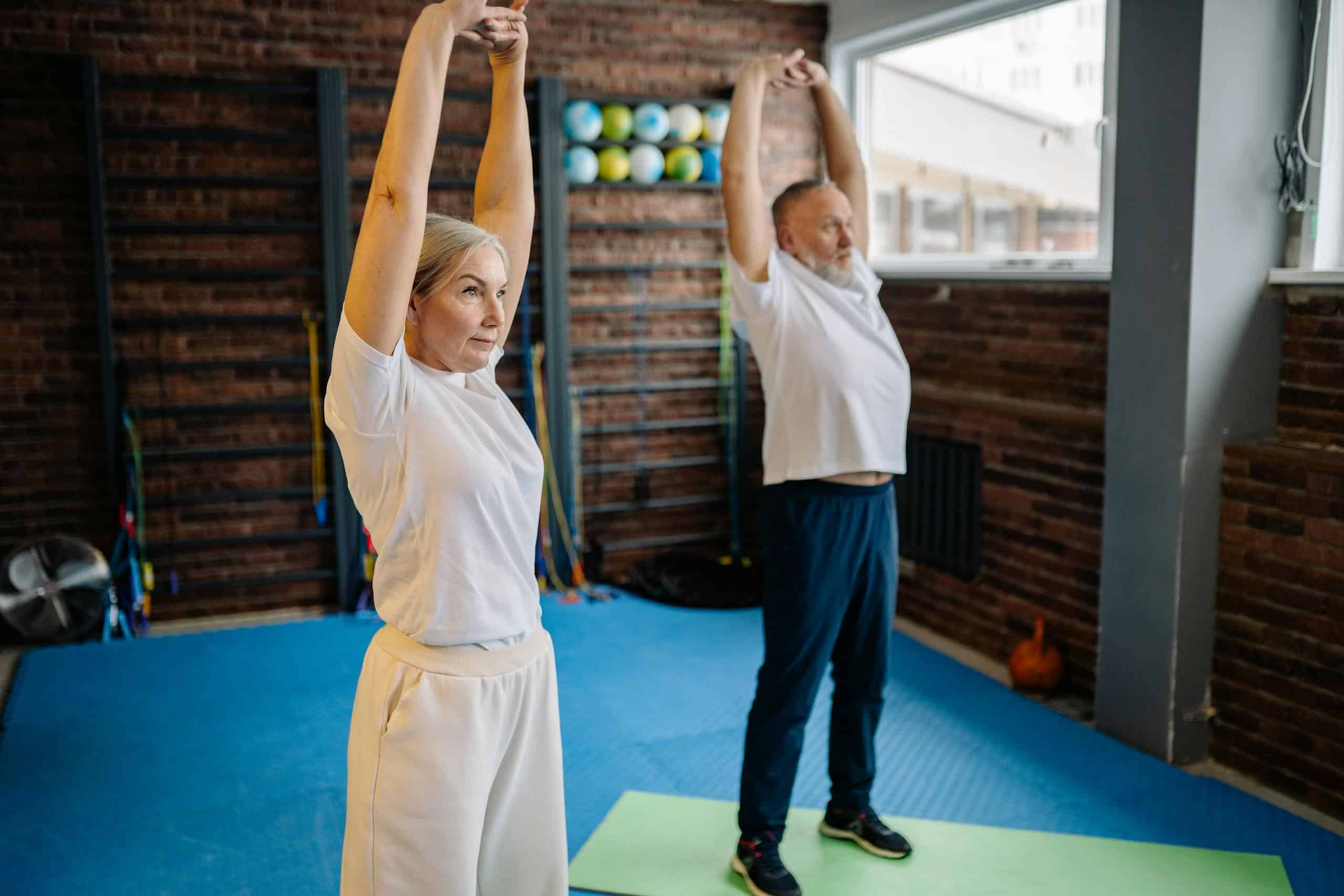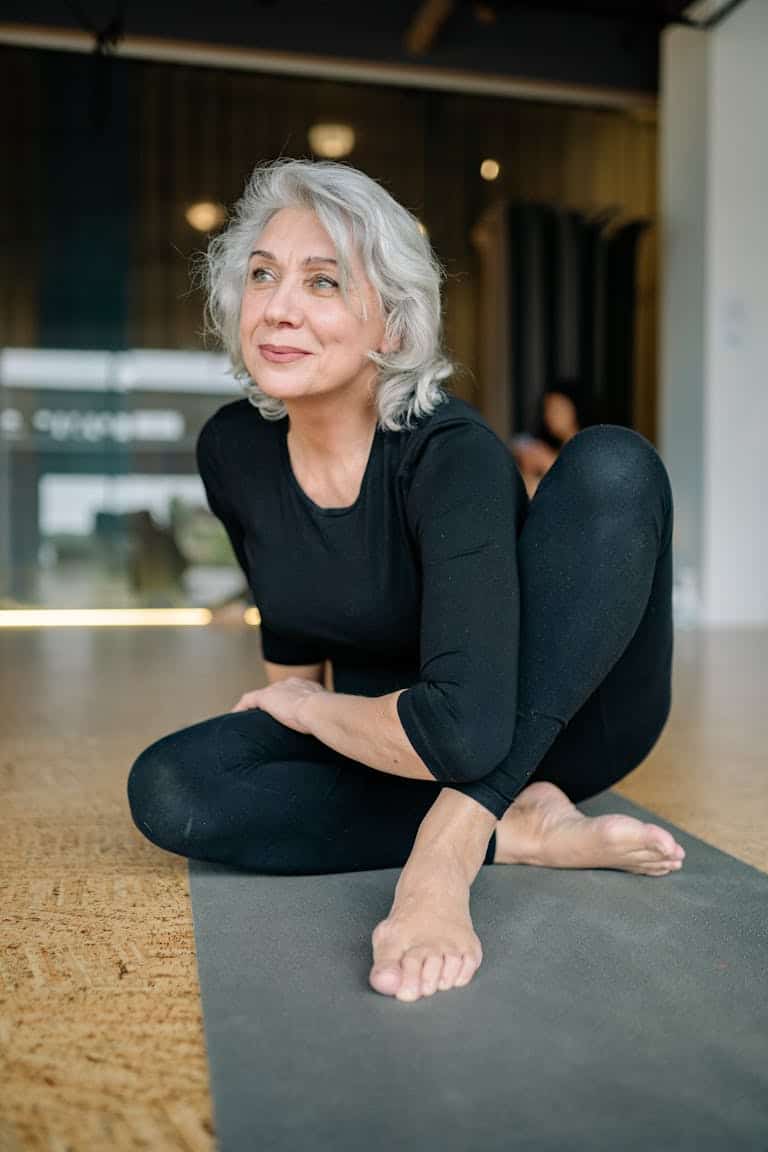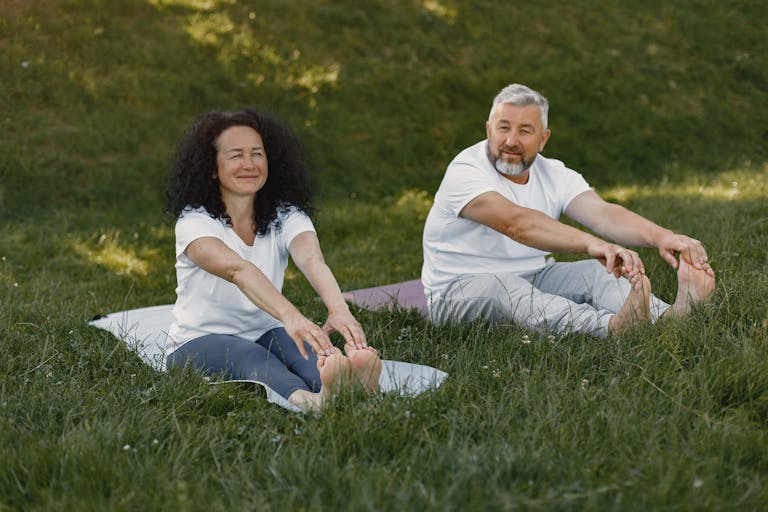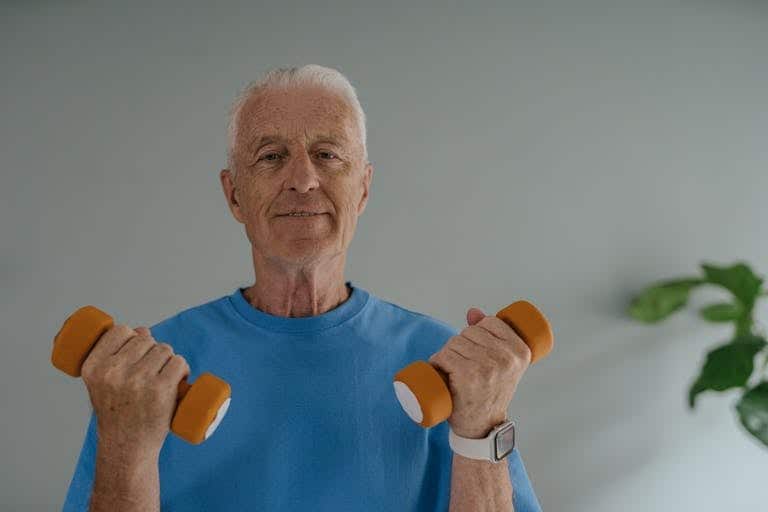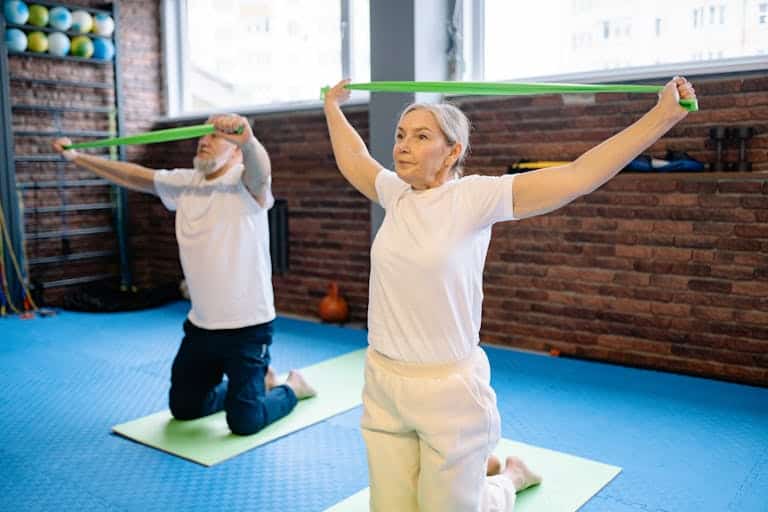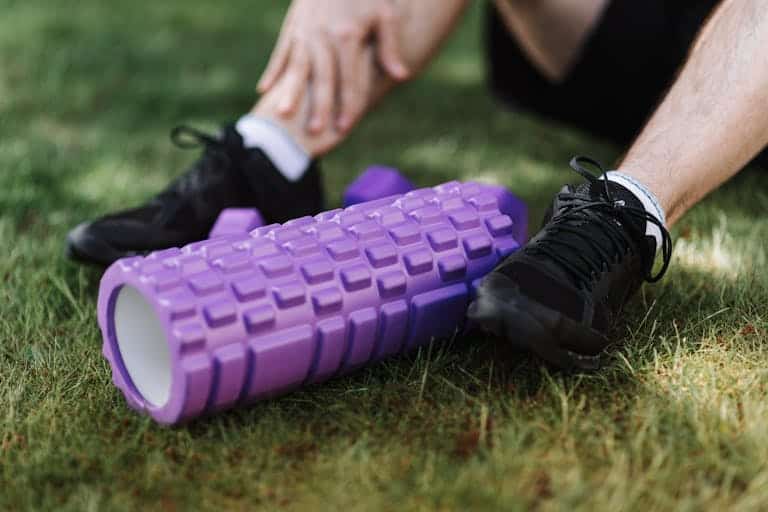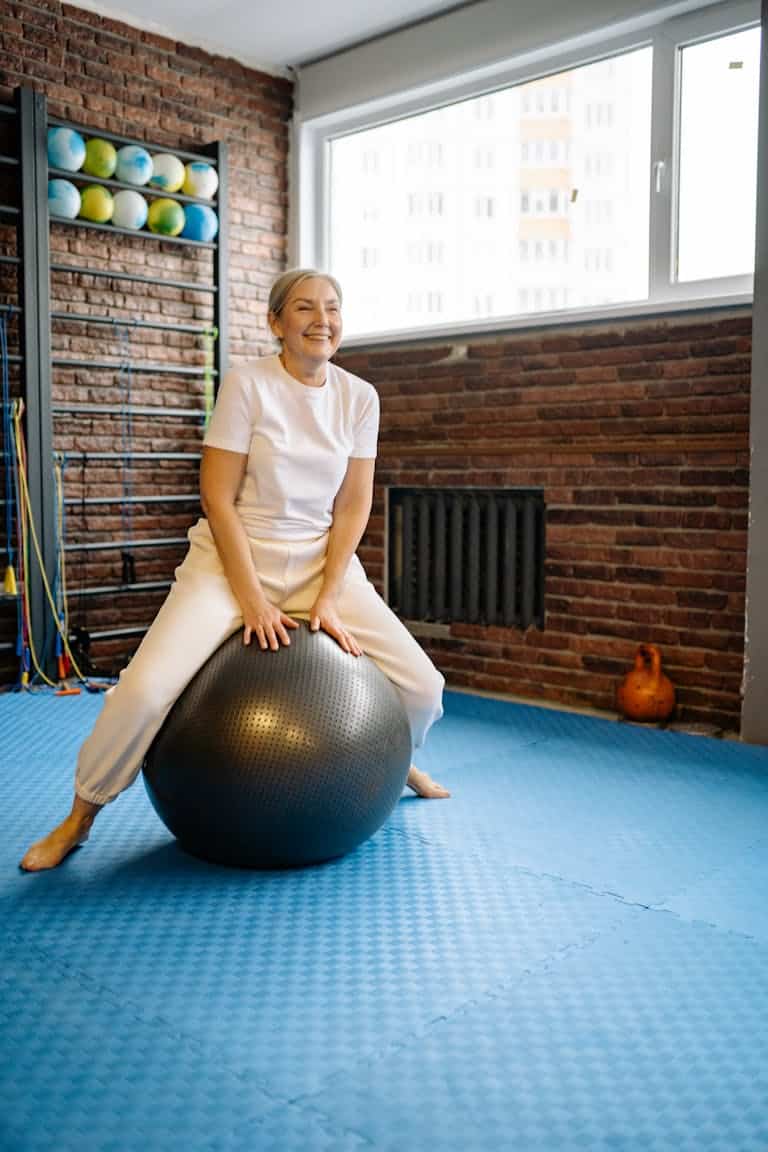Creating a Budget-Friendly Home Gym for Seniors: Essential Gear
Disclosure: My rankings are meticulously crafted using advanced algorithms that analyze a vast number of customer reviews, assessing everything from product quality and brand reputation to customer service and popular trends. While these rankings are based on my independent evaluations and intended to serve as a helpful starting point for your shopping journey, it’s worth noting that by purchasing through my recommendations, you’ll access the best prices I’ve found. Additionally, I may earn a commission at no extra cost to you, which supports my ability to continue offering valuable insights.
Introduction
As we age, staying active becomes one of the most important ways to maintain independence, mobility, and overall health. However, it’s not always easy to find a fitness solution that fits your lifestyle, especially if you’re not keen on heading to the gym. That’s why setting up a home gym for seniors can be a game-changer—offering convenience, safety, and the freedom to work out on your own terms. The good news? You don’t need a huge space or expensive equipment to create an effective and senior-friendly workout zone at home.
This post builds on the ideas we covered in our Ultimate Guide to Active Aging and Physical Fitness for Seniors, where we emphasized the importance of physical fitness for aging well. Here, we take that concept further by showing you how to create a home gym on a budget, without sacrificing the quality of your workout or compromising on safety.
“It’s never too late to start improving your health. Every small step leads to a healthier, happier you.” – Unknown
This couldn’t be truer for seniors looking to start exercising at home. For seniors looking to avoid the complexities of gym memberships or long travel times, this makes a home gym setup an ideal solution.
If you’re ready to enhance your fitness routine while staying within your comfort zone, keep reading. We’ll break down the essential equipment that fits your needs, supports mobility and strength, and most importantly, keeps you safe while staying active at home. And don’t worry, we’ve got you covered with internal links to useful exercises, like our 10 Essential Exercises for Seniors to Dramatically Improve Balance and Coordination, to make sure your fitness journey is supported with practical, step-by-step advice.
So, let’s get started. Building your home gym isn’t just about getting some gear; it’s about investing in your health and longevity for the long term.
Why Build a Home Gym for Seniors?
When it comes to staying fit as a senior, the benefits of regular exercise are clear. But here’s the thing—going to the gym isn’t always practical or appealing. Whether it’s because of the hassle of travel, crowded spaces, or just the desire to exercise in the comfort of your own home, setting up a home gym for seniors offers a perfect alternative. Let’s break down why creating a home gym might just be the best decision you’ll make for your health.
Convenience, Safety, and Cost-Effectiveness
First off, convenience is a major plus. You can work out whenever it fits your schedule, whether it’s early morning or late afternoon. No more worrying about gym hours or whether it’s too cold outside to travel! Exercising at home gives you the flexibility to maintain a routine that works for you. Plus, there’s the added benefit of safety—particularly during flu seasons or pandemics. With your own equipment, there’s no need to worry about shared spaces, and you can exercise in an environment that’s comfortable and familiar.
And let’s talk about cost-effectiveness. Gym memberships can be expensive, especially when you factor in transportation or class fees. By investing in just a few pieces of budget-friendly equipment, you can save money in the long run. We’ll show you later how a few versatile tools like resistance bands or stability balls can provide a full-body workout without breaking the bank.
“Those who think they have no time for exercise will sooner or later have to find time for illness.” – Edward Stanley
This quote hits the nail on the head. Making time for exercise now, from the convenience of your own home, is an investment in your long-term health and independence.
Maintaining Physical Health, Strength, and Mobility as a Senior
It’s no secret that staying fit becomes more important as we age. Regular physical activity can improve mobility, prevent falls, and help manage chronic conditions like diabetes or arthritis. Unleashing the Golden Years: A Comprehensive Guide to Elderly Wellness covers the holistic benefits of staying active, but here’s a quick reminder: exercise is crucial not just for physical health but for mental well-being, too. Building strength, flexibility, and endurance helps seniors stay independent for longer, maintaining the ability to perform daily tasks with ease.
In fact, a 2022 study by Schaller et al. demonstrated how even simple, machine-based exercises in retirement homes led to significant improvements in strength, mobility, and confidence among seniors (Schaller et al., 2022). Imagine what a home setup could do! You’ll be able to work at your own pace, focusing on your specific fitness needs, whether it’s strength, balance, or flexibility.
Promoting Daily Activity Without the Pressure of a Commercial Gym
One of the best things about a home gym is that it takes away the pressure of having to perform in a public space. There’s no waiting for machines, no crowded rooms, and no comparing yourself to others. You can create a workout that’s as simple or advanced as you need. Whether you’re doing a quick session in the morning or spending more time focusing on balance exercises, the pace is entirely up to you.
By creating a home gym for seniors, you’re setting yourself up for success. You can incorporate simple routines, like the ones outlined in How to Start a Walking Program for Seniors, into your daily schedule without feeling like it’s a chore. The result? You’ll stay active, build strength, and feel more confident in your mobility—all from the comfort of your home.
Building your home gym not only makes fitness more accessible but ensures you’re making the most out of your golden years. Whether it’s improving strength, maintaining mobility, or simply staying active in your day-to-day life, a home gym is a simple yet powerful way to take control of your health.
What to Consider When Setting Up a Senior-Friendly Home Gym
Building a home gym for seniors doesn’t require a massive space or a huge budget. With a little planning, you can create an efficient workout area that suits your needs and keeps you safe. In this section, we’ll cover some important considerations, from optimizing small spaces to ensuring your gym is affordable and safe.
Optimizing Small Spaces: Multipurpose Equipment for Compact Areas
One of the best things about setting up a senior-friendly home gym is that you don’t need a ton of space. Many seniors live in apartments or smaller homes, but that doesn’t mean you can’t create a functional workout area. The key is to focus on multipurpose equipment that allows you to do a variety of exercises without cluttering your space.
For example, resistance bands and light dumbbells are compact yet highly versatile. You can use them for strength training, stretching, and even balance work. Another great addition is a stability ball, which can be used for core exercises and improving balance, all while taking up minimal space.
By investing in equipment that serves multiple purposes, you’ll get more out of your home gym without sacrificing square footage. If you’re working in a particularly tight space, consider equipment that can be easily stored away, such as foldable mats or compact exercise bikes.
Safety First: Stability, Low-Impact Exercises, and Proper Flooring
When setting up a home gym for seniors, safety is priority number one. Choosing the right equipment and creating a secure environment is crucial to preventing falls or injuries, especially if you’re focusing on exercises that require balance or mobility.
Make sure you have non-slip flooring or exercise mats to prevent falls, and avoid high-impact exercises that put too much strain on your joints. Low-impact workouts like those using resistance bands or doing chair-based exercises are perfect for protecting your joints while still improving strength and flexibility.
Additionally, ensure your gym area is well-lit and free of clutter, and that equipment like balance bars or sturdy chairs are available for support. For seniors with arthritis or mobility challenges, adapting your workouts to suit your physical needs is crucial for long-term success and safety.
Budget Tips: Affordable Equipment and Where to Find It
Building a home gym doesn’t have to be expensive. There are plenty of ways to find quality equipment on a budget, especially when you’re just getting started. Second-hand stores, online marketplaces like Craigslist or Facebook Marketplace, and local garage sales are great places to find deals on lightly used workout gear.
You can also find affordable options online through retailers like Amazon, which often offers discounts on basic home gym essentials such as resistance bands, dumbbells, and yoga mats.
Setting up a home gym as a senior is all about making smart choices. By optimizing your space, focusing on safety, and shopping smart for affordable equipment, you can create a fitness space that’s both functional and enjoyable. Plus, you’ll be ready to stay active without ever leaving the comfort of your home.
Must-Have Equipment for a Home Gym for Seniors
When building a home gym for seniors, the right equipment is key to ensuring effective workouts that improve strength, balance, and mobility. The great news is you don’t need a large budget or a huge space. Below, we’ll look at five essential pieces of equipment that are versatile, affordable, and perfect for seniors who want to stay active and fit.

Resistance Bands: Versatile and Portable for Low-Impact Strength Training
Resistance bands are a must-have in any senior-friendly home gym. They’re lightweight, easy to store, and provide varying levels of resistance, making them perfect for low-impact strength training. Whether you’re targeting your upper body, core, or legs, resistance bands allow you to strengthen muscles without putting undue strain on your joints, which is crucial for seniors looking to avoid injury.
What makes resistance bands great for seniors is their adaptability. You can use them for seated exercises, standing stretches, or full-body workouts, all while controlling the level of difficulty by choosing the right resistance. This piece of equipment is perfect for maintaining flexibility and strength as you age.
Research supports the value of resistance training for seniors. A study by Starck et al. (2022) demonstrated the effectiveness of progressive muscle-strengthening exercises for older adults, especially when using accessible and portable equipment like resistance bands (Starck et al., 2022).
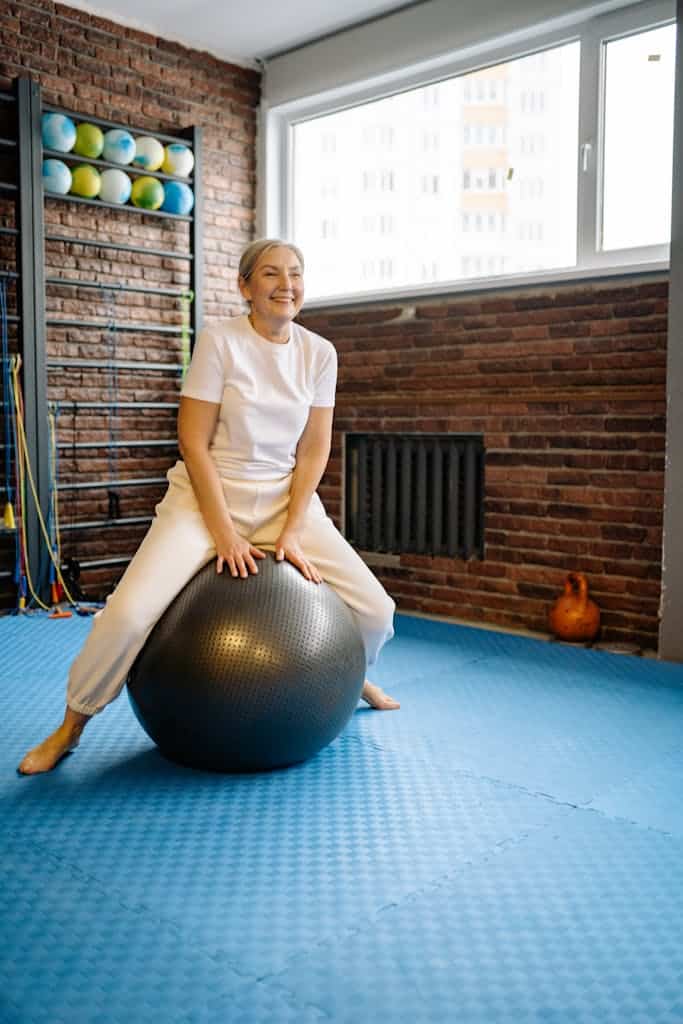
Stability Balls: Improve Core Strength, Balance, and Flexibility
Stability balls are another fantastic addition to a senior home gym. These inflatable balls help improve balance, core strength, and flexibility, all of which are important for maintaining mobility and preventing falls. By sitting or balancing on the ball while doing simple movements, you’re engaging multiple muscle groups, which leads to better posture and coordination.
Stability balls are ideal for seniors because they offer a gentle way to strengthen muscles and improve stability. Whether you use it for seated exercises or balance drills, a stability ball adds an element of fun while working on essential skills.
If you’re looking for balance-focused workouts to incorporate into your routine, check out 10
Powerful Exercises for Seniors to Boost Balance and Coordination for easy exercises that can be done with or without equipment like stability balls.
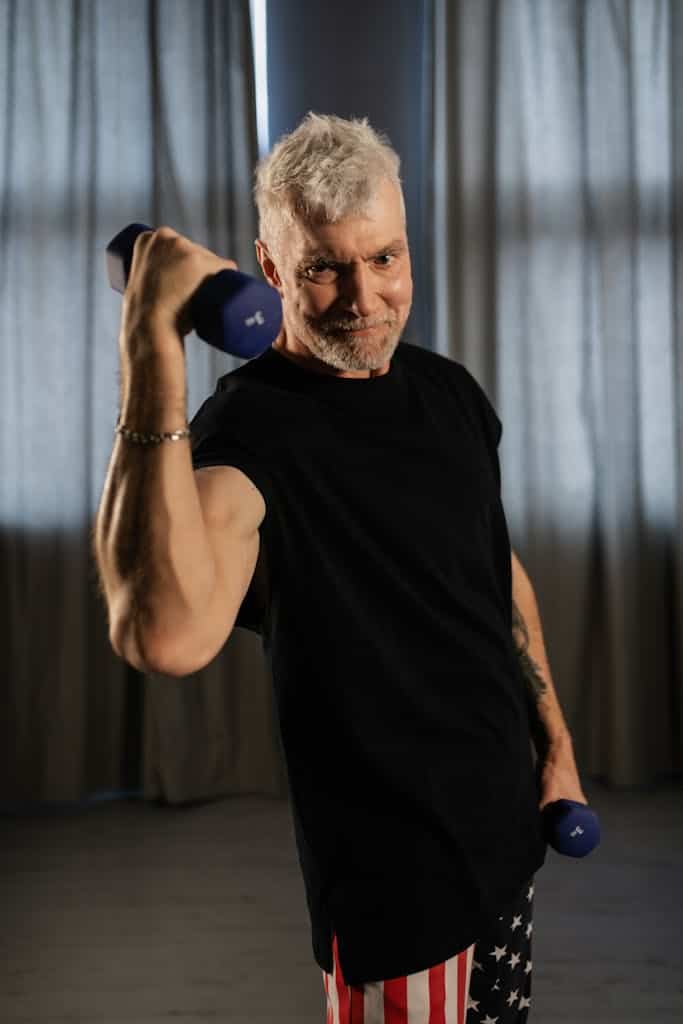
Light Dumbbells: Build Upper Body Strength Without Risking Injury
Light dumbbells are essential for maintaining upper body strength in a safe and controlled way. For seniors, lifting heavy weights can sometimes lead to injury, but using light dumbbells (usually 1-5 pounds) provides just the right amount of resistance to help strengthen your arms, shoulders, and back without the risk.
To further explore how light weights can help you build muscle effectively, check out Strength Training for Seniors: Effective Muscle Building After 60 for tips on getting the most out of your strength workouts.
Ankle Weights: Strengthen Your Lower Body
Ankle weights are perfect for adding a bit of extra resistance to lower body exercises, such as leg lifts, seated marches, or even light walking. They are adjustable, making them a great fit for seniors who want to start with lower weights and gradually increase the intensity as they grow stronger.
These are especially useful for building leg and hip strength, which is crucial for maintaining mobility and balance as you age. Plus, they can be used during simple, everyday movements to help tone your muscles without adding strain.
Chair or Balance Bar: Essential for Stability and Support
Having a sturdy chair or balance bar is critical for performing balance exercises safely. For seniors, these items offer the extra support needed to maintain stability during standing exercises or stretches. They’re also useful for those who may feel uneasy performing certain movements without additional assistance.
Balance exercises are critical for reducing the risk of falls, and having a chair or bar to hold onto during these exercises offers both security and confidence. Whether you’re performing seated stretches or standing balance exercises, this simple addition can make a big difference in your safety and effectiveness during workouts.

As Khloe Kardashian wisely said, “Fitness is not about being better than someone else. It’s about being better than you used to be.”
Remember, every bit of progress counts, and with the right tools, you can continue improving your strength and balance over time.
By incorporating these five pieces of equipment into your home gym for seniors, you’ll have a well-rounded setup that covers all the bases: strength, balance, and flexibility. Whether you’re starting with resistance bands or looking to add light dumbbells, these tools are simple, effective, and designed to help you stay fit and active.
Optional But Useful Additions to Enhance Your Home Gym
Once you’ve set up the basics of your home gym for seniors, you might find that adding a few extra pieces of equipment could take your workouts to the next level. These additions aren’t strictly necessary, but they can make your exercises more comfortable, enjoyable, and efficient. Let’s take a look at some optional gear that could enhance your fitness routine.
Yoga Mat: Cushion and Support for Floor Exercises
A good yoga mat is an essential piece of equipment for any home gym, especially for seniors who want to incorporate stretching, floor exercises, or yoga into their routines. It provides the necessary cushion for your joints, protects your back during exercises, and gives you a non-slip surface for safety. Whether you’re doing light stretches, chair yoga, or even some bodyweight exercises, having the right mat underfoot can make a world of difference.
For seniors focusing on flexibility, a yoga mat makes it easier to do exercises like seated stretches or gentle yoga poses without discomfort. If you’re wondering how to incorporate stretching into your routine, be sure to check out Best 15 Yoga Mats for Seniors to Enhance Flexibility for tips on selecting the right mat for your needs.

Stationary Bike or Elliptical: Gentle Cardio Machines
Adding a stationary bike or elliptical machine to your home gym can be a fantastic way to include gentle, low-impact cardio in your workouts. These machines are ideal for seniors because they provide an excellent cardiovascular workout without the high impact of running or jumping exercises. This makes them easy on the joints while still helping to burn calories, improve endurance, and maintain overall heart health.
The best part about stationary bikes and ellipticals is their adaptability. You can go at your own pace, whether it’s a light pedal while watching TV or a more focused workout. Plus, they don’t take up much space and are relatively easy to store. For seniors just starting with cardio, this equipment allows you to stay active without stressing your knees or hips.
In fact, a study by Forte et al. (2021) highlighted the effectiveness of low-impact machines like ellipticals and stationary bikes in improving postural control, dynamic balance, and strength in older adults. The study found that using this type of equipment as part of a strength and motor skills program helped seniors enhance their balance and reduce the risk of falls (Forte et al., 2021). This makes investing in such equipment not just about staying fit but also about improving overall mobility and stability.
As Jim Rohn wisely said, “Take care of your body. It’s the only place you have to live.”
Investing in a stationary bike or elliptical isn’t just about working out—it’s about making a long-term investment in your health, supporting both cardiovascular fitness and balance.
Foam Rollers: Muscle Recovery and Circulation
Foam rollers are excellent tools for muscle recovery and improving circulation, especially after strength training or more strenuous workouts. They’re a simple and affordable addition to any home gym and can help with reducing muscle tension, improving flexibility, and enhancing overall recovery after a workout.
Foam rolling is a form of self-myofascial release, which can help relieve tightness in muscles and increase blood flow to the area. For seniors, this is particularly beneficial for managing soreness or stiffness after exercising. Incorporating foam rolling into your post-workout routine can keep your muscles healthy and flexible, making it easier to stay active day after day.
Treadmill with Safety Handles: Controlled Walking Routines
For seniors looking to maintain a regular walking routine, a treadmill with safety handles is an excellent investment. Walking is one of the simplest and most effective exercises for seniors, and having a treadmill at home means you can walk comfortably and safely, regardless of the weather outside.
The safety handles provide extra stability, making it easier to maintain balance while walking at a steady pace. Whether you’re trying to reach a daily step count or just keep your legs moving, a treadmill is a controlled environment that allows you to exercise without worrying about uneven terrain or outdoor conditions.
These optional pieces of equipment can elevate your home gym experience, providing variety, comfort, and safety in your workouts. Remember, though, you don’t need to get all of these at once—start with the basics, and over time, you can decide which pieces might make your routine more enjoyable and effective.
How to Stay Safe While Exercising at Home
Exercising at home offers plenty of convenience and flexibility, but it’s essential to prioritize safety to avoid injury and ensure long-term success. In this section, we’ll discuss a few key safety tips that will help you maintain a safe and effective routine, from warming up to maintaining proper posture.
Warm Up and Cool Down: The Importance of Stretching
One of the simplest yet most important ways to stay safe while exercising at home is to warm up and cool down before and after your workout. Warming up increases blood flow to your muscles, preparing them for more intense movement, while cooling down helps your heart rate return to normal and reduces the risk of muscle soreness.
For seniors, proper stretching can also help prevent injuries. Focus on gentle stretches that target major muscle groups, such as the shoulders, hamstrings, and lower back. This is especially important for older adults who may be more prone to stiffness or reduced flexibility. A 5-10 minute warm-up or cool-down can make all the difference in how your body feels during and after your workout.
Monitor Your Progress: Avoid Overexertion
It’s important to monitor your progress to ensure you’re not pushing yourself too hard, especially if you’re just starting a new routine. Keeping track of your fitness routine will help you avoid overexertion, which can lead to injury or burnout. Simple tracking methods, such as writing down your workouts in a journal or using a fitness app, can help you see how far you’ve come and make sure you’re gradually increasing intensity.
As with any new exercise routine, it’s crucial to start slow and gradually build up the intensity. For example, begin with light weights or low-resistance bands before progressing to more challenging exercises. Doing too much too quickly can result in muscle strain or fatigue, which could derail your fitness goals.
Proper Posture: Prevent Injury with Good Form
Maintaining proper posture during exercises is another critical element of staying safe. Poor posture can lead to muscle strain, joint pain, and even long-term injuries, especially for seniors who may already have weakened muscles or decreased mobility.
Focus on keeping your back straight, shoulders relaxed, and core engaged during all exercises. This is particularly important during strength training or balance exercises, where maintaining good form is key to preventing injury. If you’re using equipment like resistance bands or dumbbells, be mindful of your movements and avoid hunching or overextending.
As Gene Tunney said, “Exercise should be regarded as a tribute to the heart.”
This reminder helps keep your focus on doing exercises that support both your physical health and your well-being, without taking unnecessary risks.
For seniors with arthritis or limited mobility, proper posture is even more important. To learn more about how to modify exercises safely, check out our article on How to Modify Common Exercises for Seniors with Arthritis for tips on staying active while protecting your joints.
By following these simple safety tips—warming up, monitoring your progress, and maintaining good posture—you can enjoy a safe and effective workout routine right from the comfort of your home.
Where to Buy Affordable Senior-Friendly Gym Equipment
Setting up a home gym doesn’t have to be expensive. With some strategic shopping, you can find high-quality, senior-friendly workout gear at a fraction of the price. Here are some of the best places to look for affordable gym equipment, whether you prefer shopping online or exploring local options.
Online Stores: Amazon, eBay, and Budget-Friendly Sections
Shopping online is one of the easiest ways to find a wide range of affordable fitness equipment for seniors. Retailers like Amazon and eBay offer countless options for senior-friendly gear, from resistance bands to light dumbbells. Amazon often features budget-friendly sections where you can find discounted items, and with the added benefit of customer reviews, you can make sure the equipment is high quality and meets your needs.
eBay is also a great place to score used or refurbished equipment at lower prices. It’s a particularly good option for items like treadmills or stationary bikes, which tend to be more expensive when bought new. Many sellers offer free shipping or the option to negotiate prices, making it a flexible choice for budget-conscious shoppers.

Local Sporting Goods Stores: Sales, Clearance Sections, and Used Gear
If you prefer shopping in person, local sporting goods stores can be a great place to find affordable workout gear. Stores like Dick’s Sporting Goods or Big 5 Sporting Goods often have clearance sections where you can find marked-down items. Seasonal sales are also common, especially after New Year’s or during the back-to-school season, when many people are buying new fitness equipment.
Another great tip is to check for used gear at these stores. Many stores sell refurbished equipment or accept trade-ins, so you can pick up high-quality items at a reduced price. Always ask the staff about upcoming sales or discounts—you might be surprised at the deals available.
Second-Hand Options: Garage Sales, Facebook Marketplace, and Community Listings
For those who love a good bargain, shopping second-hand can be a goldmine. Garage sales and community listings on platforms like Facebook Marketplace or Craigslist often have affordable exercise equipment that’s gently used. Many people sell fitness gear they no longer need at a fraction of the cost, and in many cases, the equipment has barely been used.
This is an excellent way to find larger items like treadmills or elliptical machines without paying full price. Just be sure to inspect the equipment carefully to ensure it’s still in good working condition. You can also check with local community centers or gyms that may occasionally sell older equipment to make room for new models.
“Do what you can, with what you have, where you are.” – Theodore Roosevelt
This quote serves as a reminder that you don’t need the fanciest or most expensive equipment to get started. With a little creativity and smart shopping, you can create a fully functional home gym without overspending. For more ideas on joint-friendly and senior-safe workout equipment, check out our article on Top 5 Joint-Friendly Workout Equipment for Older Adults to explore even more affordable options.
By exploring these options, you can easily find affordable, senior-friendly gym equipment that fits your budget and workout needs. Whether you prefer shopping online, in stores, or second-hand, there are plenty of ways to stock up on essential gear without breaking the bank.
Conclusion
Creating a home gym for seniors doesn’t have to be complicated or expensive! With just a few carefully selected pieces of equipment, like resistance bands, light dumbbells, or a stability ball, you can set up a space that’s perfect for maintaining your fitness and staying active right at home. The key is to focus on safety, versatility, and simplicity when choosing your equipment.
Remember, whether you’re aiming to improve strength, mobility, or balance, it’s easy to build a routine that suits your needs—without breaking the bank. By incorporating the essential equipment we’ve discussed, and exploring useful additions like yoga mats or stationary bikes, you can create a well-rounded fitness space that supports your overall well-being.
As motivational speaker Zig Ziglar once said, “You don’t have to be great to start, but you have to start to be great.”

It’s never too late to make fitness a part of your daily routine. So, take the first step today and enjoy the lifelong benefits of staying active and healthy! And if you’re looking for a little extra motivation or social interaction, consider reading about the benefits of Senior Group Fitness: Maximize Social Benefits with Every Class for tips on how to make fitness even more enjoyable.
Reference
- Schaller, N., Krusemark, H., Mende, E., Weiß, M., Spanier, B., Zelger, O., Bischof, J., Haller, B., Halle, M., & Siegrist, M. (2022). Bestform-F – Best function of range of motion: A feasibility study of a multimodal exercise training program for older adults in retirement homes. Clinical Interventions in Aging, 17, 1069-1080. https://doi.org/10.2147/CIA.S367858
- Starck, H., Kalmari, P., Saloranta, E., & Borodulin, K. (2022). Progressive muscle-strengthening exercise is feasible among older people in the ‘Strength in Old Age Program’. The European Journal of Public Health, 32(Supplement 2). https://doi.org/10.1093/eurpub/ckac093.026
- Forte, R., Ditroilo, M., Boreham, C., & de Vito, G. (2021). Strength training and gross-motor skill exercise as interventions to improve postural control, dynamic functional balance, and strength in older individuals. The Journal of Sports Medicine and Physical Fitness. https://doi.org/10.23736/S0022-4707.21.11947-4

